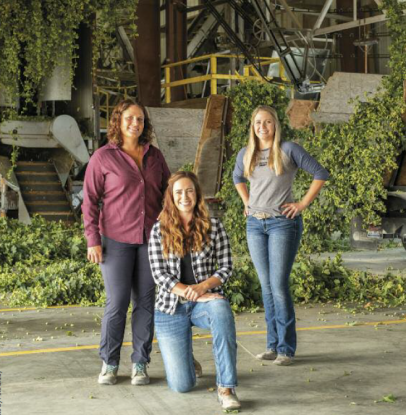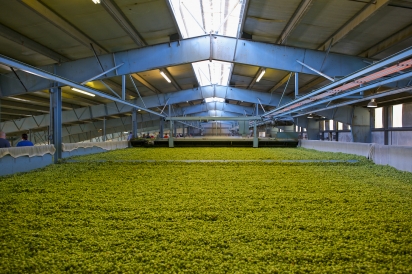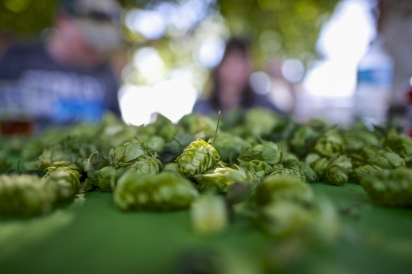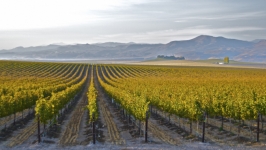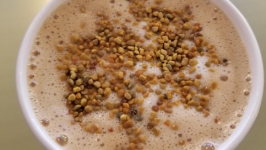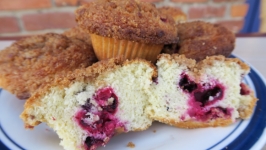Hop Sisters: As Idaho Gains in Producing a Key Brewing Ingredient, Women Lead the Way
In the triangle of Idaho delineated by Highway 26, Highway 95 and the Snake River stand field after field of silent sentinels, 18 feet high, penned in by what looks like a stockade, as if without it they would go marching out some moonless night to take over the countryside. Actually, it’s hops, and thanks to the surging craft beer industry, Idaho stands second only to Washington in U.S. production.
Unlike the average Idaho farmer, whose mean age is 57, members of the hop industry in southern Idaho are relatively young. That’s partly because the southern Idaho hop industry is still run by extended families, according to members of one such Parma family, the Goodings.
“It reflects the change of the brewing industry,” said Michelle Gooding, 28, who along with her two sisters—Diane, 34, and Andrea, 23—comprise the sixth generation of the family to farm hops, currently on 900 acres. Their dad Michael Gooding is now 60 and semiretired, though he still offers advice.
“Our dad is great,” Diane said. “He raised us to be very strong, savvy, independent women. People have welcomed us,” partly due to their stature as a sixth-generation legacy farm.
One Auburn University study found that 29% of brewery workers were women, and that diversity is trickling down to the suppliers as well, Diane said. Hops is no exception, with other women-owned hop farms in Oregon and Washington, they said. And kitty corner to one Gooding family hops field is Mill 95, the only hops pelletizing factory in Idaho, also run by women.
Like many specialty crops, hops technology is a bit behind the rest of agriculture because it takes so much money and investment, said Diane. A perennial plant, hops are planted in hills along rows, supported by a trellis that’s built around the field. each plant is trained by hand to wind clockwise around a cable that reaches 18 feet high. The height is planned so that the plants reach it around the summer solstice, June 22, and then they have about two more weeks of growth before they start growing the “arms” on which the hop cones grow.
“If you push them taller, they might not ‘arm out’ as well,” reducing the yield, Michelle said. Hop plants are either male or female, and only the female plants produce cones.
Harvesting happens in late August, Diane explained. First, a tractor goes down the alley between the rows, cutting the bines (unlike vines, which use tendrils or other means to attach themselves to structures, bines have hairy stems that help them climb) and pushing a truck, into which the bines fall. The bines are then hung, by hand, upside down in the hop picker and travel into a stationary combine where the cones are stripped from their bines. From there, the cones are taken to the dryer, where they’re dried for six to 12 hours at 125° to 135° using air heated by natural gas.
“It’s like standing in front of a really big jet engine,” michelle said.
The drying process reduces the moisture in the hops, making the crop less perishable and more stable. “In Germany, it’s all computerized, but we do it by feel,” michelle said. The cones are dried from 75–80% moisture down to 8–10%. Like hay, hops are stored in bales and, like hay, if the crop isn’t dry enough, it could rot or spontaneously combust, as well as potentially being rejected by the buyer, she warned.
(If all of this sounds like growing and processing marijuana, there’s a reason. “They’re cousins,” Michelle said, both part of the Cannabaceae family.)
Hops add flavor and character to beer based on two characteristics: alpha acids, which provide bitterness, and aroma, which provides flavor. There are 80 varieties of hops, and the Goodings grow 15 of them on their farm. In addition, they grow 56 varieties in a single three-acre field as research for the Idaho Hop Commission, on which Diane and Michelle serve and which their dad used to chair.
Once the hops are harvested, that’s where a processor like Mill 95 comes in, said Meagen Anderson, sales manager. “We take dried and cooled hop cones and process them into pellets, which is what most brewers use to introduce them to beer to add bitterness and aroma,” she said. Before Mill 95 started in August 2017, Idaho hop growers often had little opportunity to market their crop as “Idaho Grown.” They sent their hops all the way to Yakima, Washington, to be processed, mixed with hops from other states, then sent back to Idaho craft brewers as a generic product. Mill 95 changed that. Now Idaho hops can be called Idaho hops.
After the hops are inspected, they’re pulled into a very cold environment where the 200-pound bales are pushed into a hammer mill, broken into a powder and pressed into a pellet die where they end up looking like rabbit food, Anderson said.
That is, until you rub them together. “I love asking people what they smell, because I get these wonderful descriptors from all these things in their lives,” ranging from pine to grapefruit to tropical fruit, Anderson said.
The pellets are then placed in low-oxygen mylar bags and flushed with nitrogen to help preserve them. The entire process is intended to help preserve the oils in the hops. “You’re dealing with what’s essentially a flower,” Anderson said. “It’s sensitive to heat, stress and oxygen.”
To Anderson, who’s been working in the brewing industry for 12 years with a number of mostly female organizations, women in the Idaho brewing industry isn’t that surprising. “It brings an additional perspective,” she said. “In Idaho we have the trifecta: women in the agricultural side—the Goodings are a great example of women who have done a great job as business people. Mill 95 is the same.” Plus, she added, Idaho has talented female brewers, including Mother Earth Brew Co., Woodland Empire Brewery, Payette Brewing Co. and Portneuf Valley Brewing. “Idaho has a very diverse and rich brewing culture, where women are contributing at a very high level.”
Gooding Farms
Mill 95 | @mill95hops
Idaho Hop Commission
Mother Earth Brew Co. | @motherearthbrewcoboise
Woodland Empire Brewery
Payette Brewing Co.
Portneuf Valley Brewing | @portneufvalleybrewing


